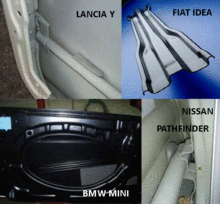Anti-intrusion bar
An anti-intrusion bar or beam is a passive safety device, installed in most cars and other ground vehicles, which must protect passengers from side impacts.[1] Side impacts are particularly dangerous for two reasons: a) the location of impact is very close to the passenger, who can be immediately reached by the impacting vehicle; b) in many side-impact accidents, the impacting vehicle may be larger, taller, heavier, or structurally stiffer than the struck vehicle. The role of an anti-intrusion bar is to absorb the kinetic energy of the colliding vehicles that is partially converted into internal work of the members involved in the crash.
Performance
The performance of a side beam is measured by several indicators. The most important are:
- the Specific Energy Absorption (SEA), which measures the amount of energy absorbed per unit mass;
- and the energy efficiency η, which is the ratio between the mean load and the peak load transmitted to the vehicle during the impact.
Furthermore:
- the amount of intrusion, for a given energy, must be as small as possible;
- the maximum depth or diameter of the bar must be reasonably small, as the vehicle door does not generally allow much space;
- the cost of the member must be possibly small.
Typical design
The anti-intrusion beams commonly span the length of the door at about a vertical midsection of the door. As the figure shows, the typical profiles can be open or closed (tubular, usually with a round cross section).

They are conventionally made by stamping or hydroforming processes. When the cross section is closed, the tubes can be used as-received. In the scientific and technical literature, some unconventional designs have been proposed.[2]
Typical materials
The anti-intrusion bars are generally made of high strength steels.[3] However, some studies indicate that stainless steel 304 might be a better choice, because of its larger plastic field and a larger amount of potentially absorbed energy before fracture.[4] In the scientific and technical literature, some unconventional material combinations have been proposed, too, e.g. based on metal foam filled tubes[5] or composite materials.[6]
References
- ↑ http://www.autosafetyexpert.com/Assets/Docs/on_the_safe_side.pdf
- ↑ http://www.ipaustralia.com.au/applicant/bond-sam/patents/AU1999065514/
- ↑ High Strength Steel for Automotive Safety Components Archived December 20, 2011, at the Wayback Machine.
- ↑ http://www.centroinox.it/sites/default/files/pubblicazioni/213A.pdf
- ↑ Strano, M.; Mussi, V.; Monno, M. (2010). "Non-conventional technologies for the manufacturing of anti-intrusion bars". International Journal of Material Forming. 3: 1111. doi:10.1007/s12289-010-0966-y.
- ↑ http://www.patentstorm.us/patents/7819462/description.html[]